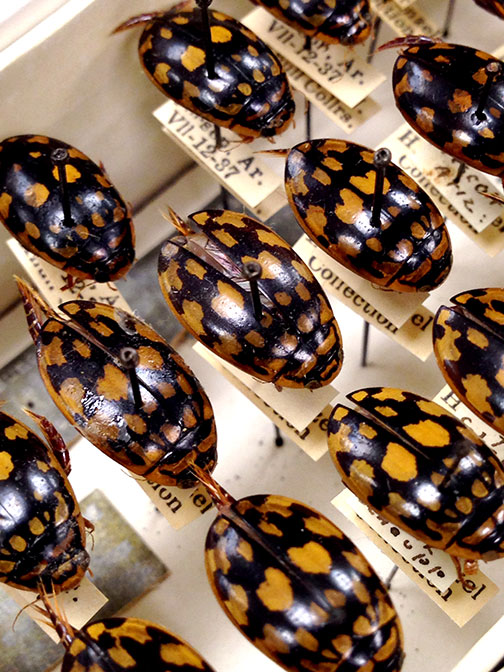Here’s one question I get frequently from visitors: “Why, oh, why, isn’t the Museum of Biological Diversity open to everyone every day?” That’s a very good question! Here’s an answer. Unlike institutions such as the Smithsonian Museum of Natural History, the Field Museum, the Carnegie Museum, or our neighbor the Cleveland Museum among others, our museum largely grew out of a background of higher education and research. We have a different structure and a different mission than these other very fine institutions. The most visible outcome of these differences is the fact that we don’t have large display areas and exhibits. We also do not have staff dedicated to public outreach. But it’s good to keep in mind that the MBD collections vary in the kinds of services they provide to the community. Each is unique in it’s own way.
My little corner of the MBD is the Triplehorn Insect Collection. We are a research facility and most of our specimens are only accessible to professional scientists and scientists in training (graduate students, postdoctoral associates, etc.) This policy gets me in trouble with a lot of people who love insects and would like to come in to “see” (many times that means “touch”) the collection. So, before anyone else gets hot under the collar about that, let’s try to understand what that policy means.
Dried insect specimens are as fragile as they are colorful and beautiful. The more they are handled and exposed to light and humidity, the faster and more likely they are to get damaged. The insect specimens in the Triplehorn collection are the result of more than 100 years of careful collecting and curation, many of them were collected in forests and meadows and prairies that do not exist anymore. These specimens are, literally, irreplaceable, and it is our responsibility to keep them intact for many more long years.
Because of that, we restrict access to the specimens to only the people who must use them for scientific study, professionals who have lots of experience with museum specimens and therefore are less likely to damage our precious charges. As the curator of the collection, it is my responsibility to protect and preserve the specimens for the long run. To do that I have to enforce the “restricted access” policy.
Now, the fact that we are a research collection does not mean we don’t welcome visitors. Quite the contrary! We are committed to sharing our knowledge and love of biodiversity with everyone interested. While we don’t have exhibits per se, we frequently and happily provide tours of the collection to people from the local community. Or even not so local: our audience is wide and varied, from k-12 to university classes, to family or neighborhood groups, to homeschool groups, to citizen scientists and individuals interested in local and global insect diversity.
- OSU student group visit.
- OSU student group visit.
- Art Department class visit.
- Art Department class visit.
- OSU Entomology class visit.
- OSU Entomology class visit.
Up to now we have been scheduling visits as requests come in and our time allows, but starting this month we in the insect collection will be teaming up with our colleagues in the Mollusc Division of the MBD to offer guided tours of the two collections to the general public on set dates. This initiative comes as a response to the increased interest in the collections, demonstrated by the increase in visit requests.
Tours will still be arranged in advance, but by specifying which days are open for tours we hope to make the whole process a bit easier and more predictable. The set dates might not work for all visitors, but by working together and establishing a structure for tour activities, we hope to continue serving the community without drastically increasing the work-load of our already overworked staff.
- School visit.
- School visit.
- School visit.
- School visit.
The next available dates for insect collection/mollusc collection joint tours are Friday, October 23rd and Friday, November 6th, from 1pm to 4pm. Total estimated tour time for the two collections is between 45 min to 1 hour/group. Group size limit is 20 adults. For more information or to schedule a guided tour, please contact Tom Watters or Luciana Musetti.
About the Author: Dr. Luciana Musetti is an entomologist and Curator of the C.A. Triplehorn Insect Collection.










